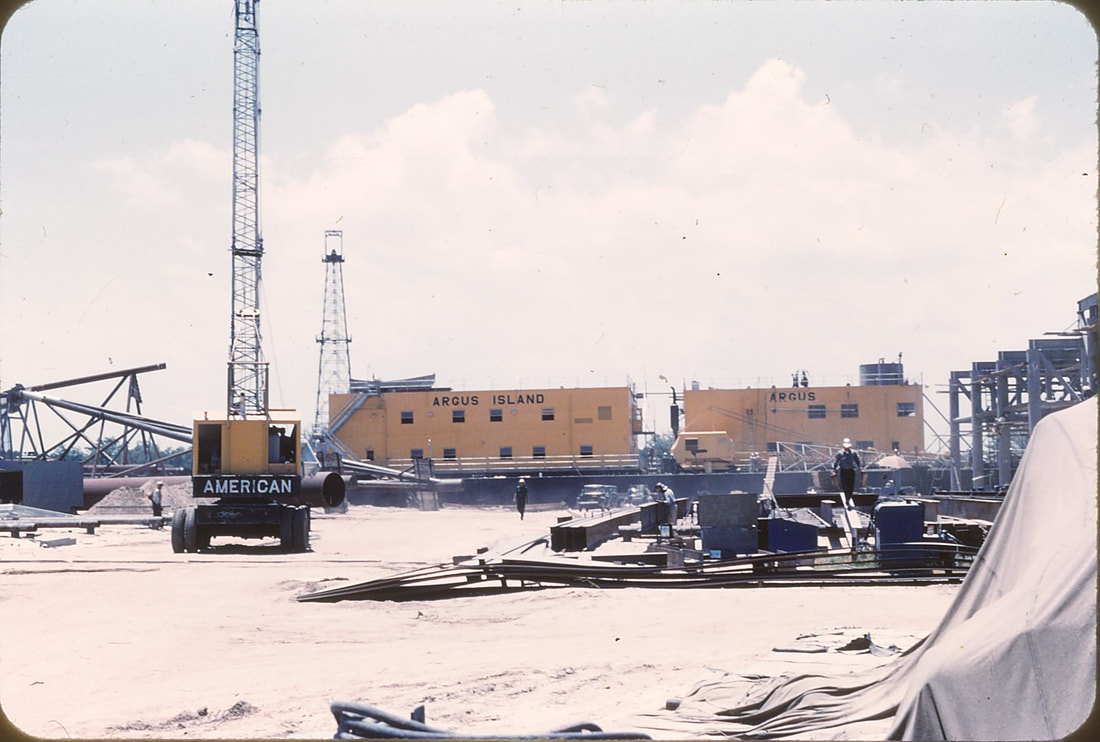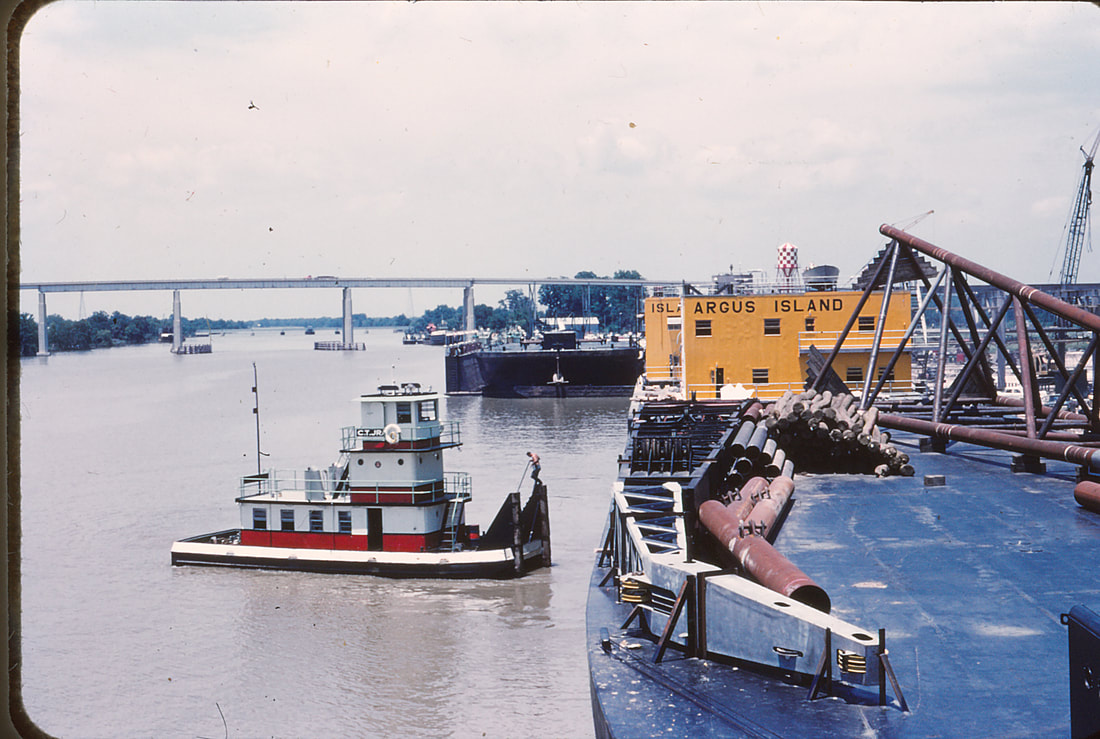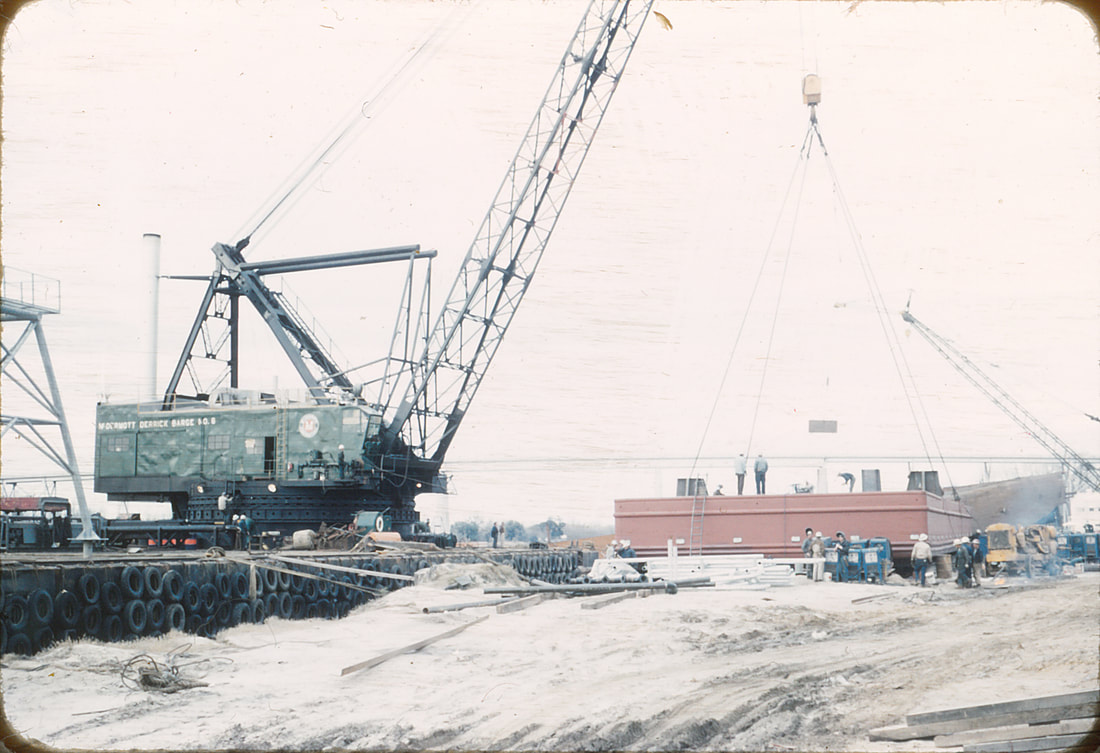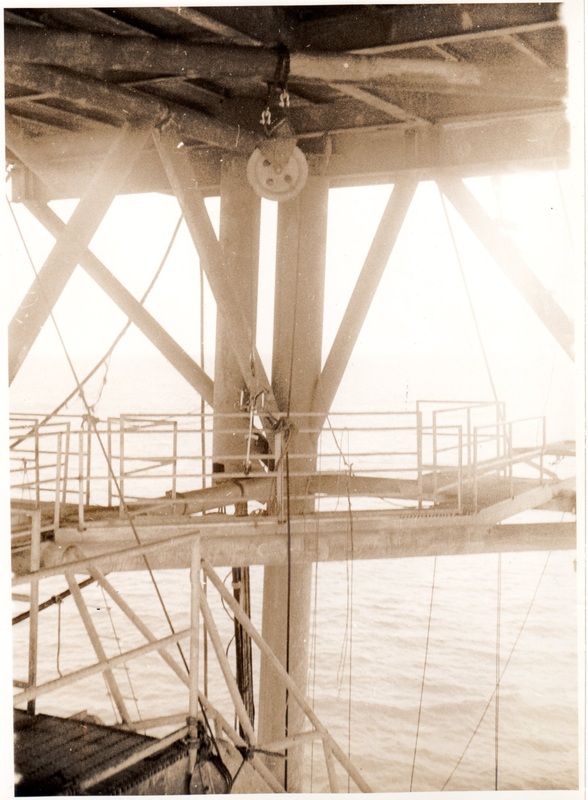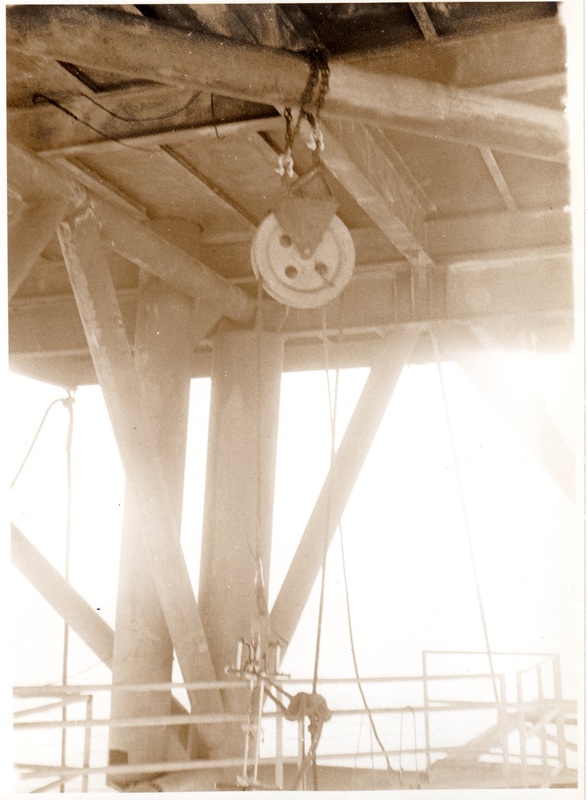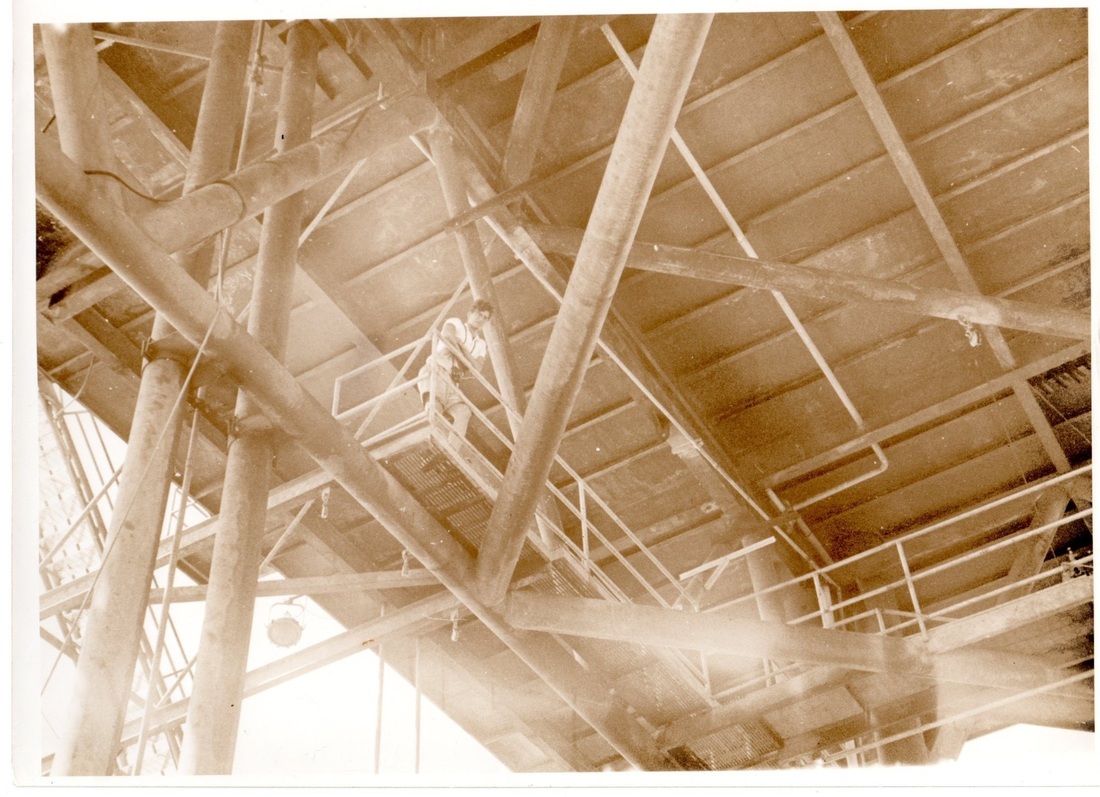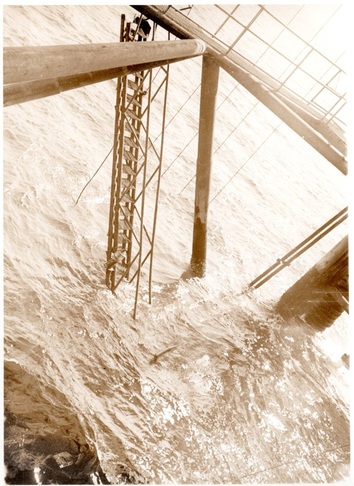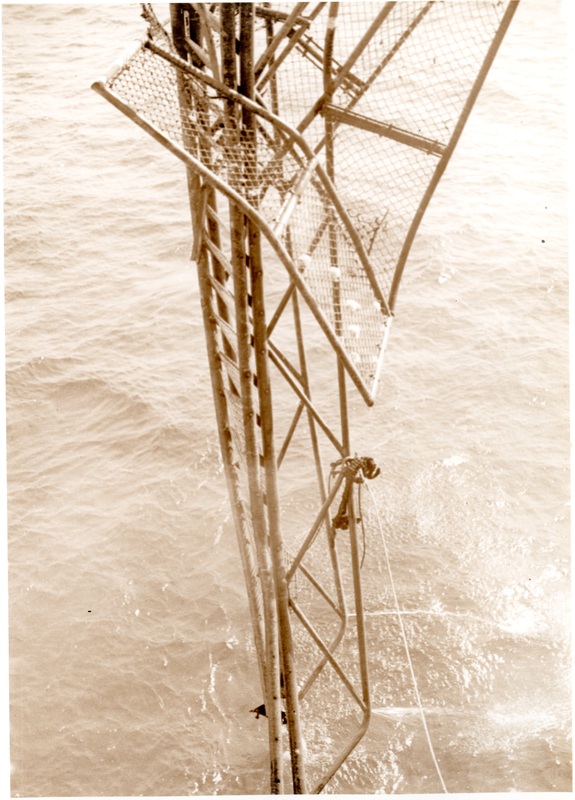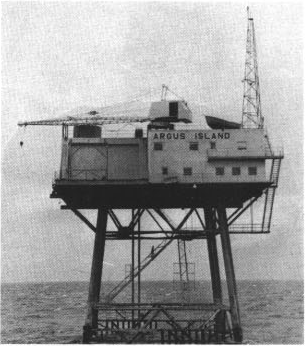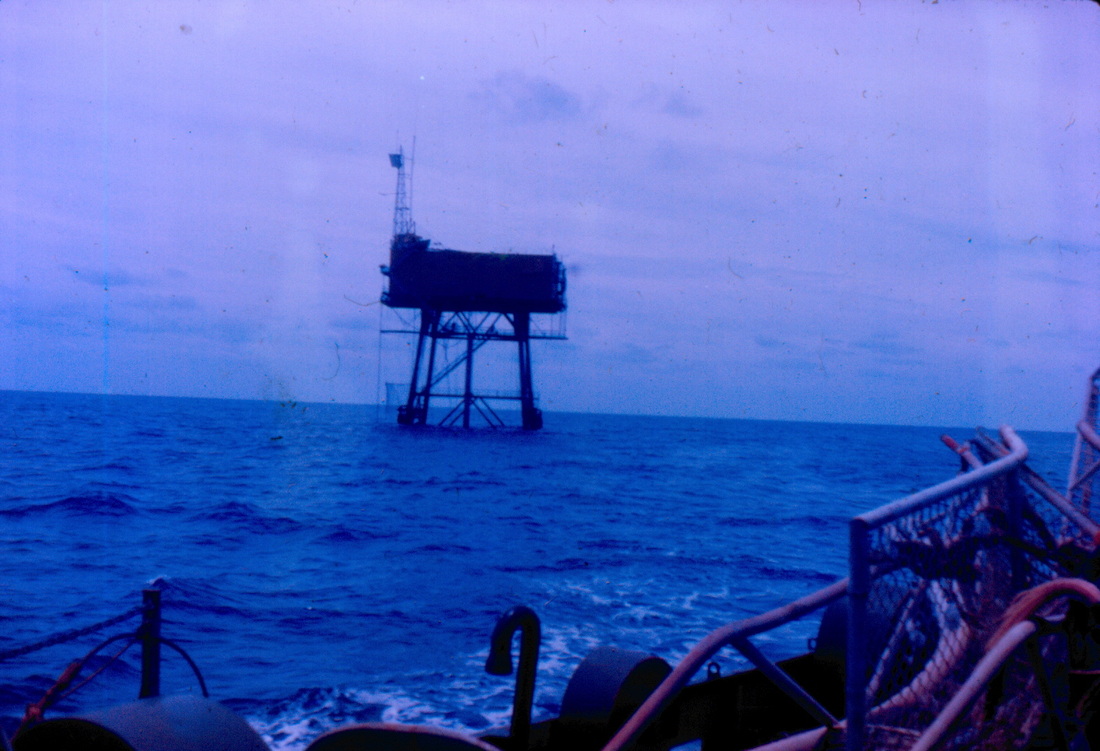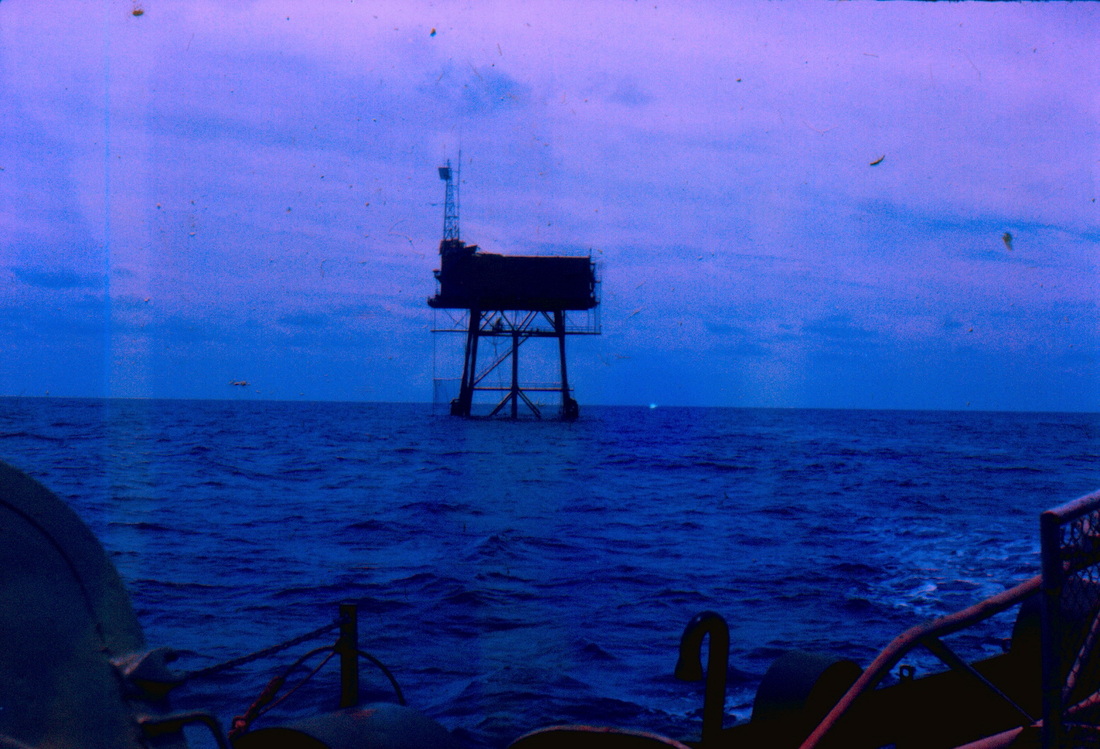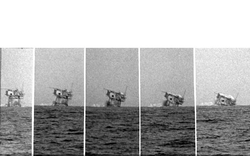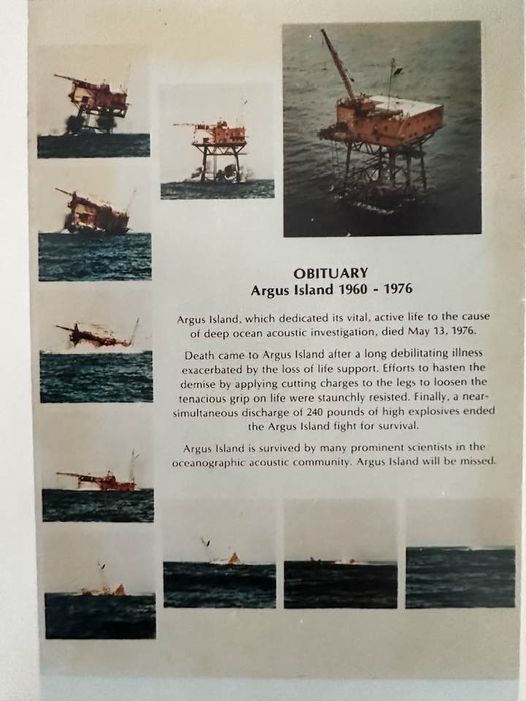|
Argus Island.
|
Argus Island - The Beginning
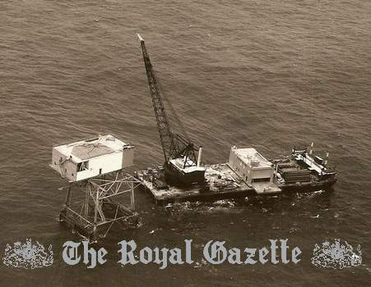
Photo courtesy of ^^^
- Argus Island under construction. Half of the upper structure is in place, the other half is still sitting on the barge.
Bill Adams: I took Rusty Tirey, Dick Fox, Fanshaw Lamb, Walt Bechmann and Bill Killhorne – he was from Washington DC. - with me to New Orleans when we went to get the T-Boat to come over here (to Bermuda), and after we got back, we got involved – I guess that was in ’51 or ’52 – somewhere in there, we had a whole year where the T-Boat went down to the Argus Banks Monday morning, come home Friday night, for one solid year, and we were doing the survey for all the recording of the data every hour, what the sea state was, what the wind is, direction, intensity, everything that we could about weather conditions in that area for a year. And that data that we collected from that was what they used to design and build the Argus Tower – to know how strong it had to be and how high off the water it had to be and stuff like that. ’51 or ’52 something like that, … the tower was put there in 1960. What they did, actually, when they actually put it there, I was out in the Pacific, so I missed all the excitement … What they did with it was … it’s in 180 feet of water, and they towed the framework of the legs, and the building and accommodation that was up top. It was a two-deck thing and it was in 2 parts on barges, and they took the legwork and sealed it all up and laid it on its side and floated it so it floated flat, and when they get down here with it, all they had to do was put a crane on it, pick one end up, and then open it up and let the water in. She just settled and they put her in place. Then they had the crane to pick up the units and put them up on top and bolt them in place. So we were involved with that too - SOFAR was, as far as Argus was concerned. Then they run into a problem once they got it there. I spent a few months, I guess, of the T-Boat supplying them, taking scientists down and whatnot… she (T-boat) just wasn’t meant for that at all.
Bruce Hallett: Sometimes you had to get out of there in a hurry.
Bill Adams: Well, actually, we got trapped under it one time and they had big 12 x 12 boards up on end bolted on to it for a cushion y’know for her and I did rip one of them off there. I thought we were going to lose the T-Boat there. When I come back, I told them straight we ain’t going back no more. The swell’s too heavy. We can’t maneuver the boat and that’s when they decided to get another boat I guess. So they found this boat down in Texas – the Mac-3 …in Houston Texas. They decided she would be a 60 footer, so the officials at Columbia, because it was Hudson Lab that wanted her, I think, which is another outfit of Columbia, but Columbia is saying ‘we ain’t having 2 different outfit running boats down there, so if you want a boat down there, it’s got to be approved by Bill Adams.’ So here I go again! So I had to go down to Texas and look her over, and eventually get he fixed up and bring her back. And after about a year and a half – 2 years I guess they decided she was too small and they got the Erline and she was in New Orleans, so the same old story – ‘if you want her and Bill Adams says she is alright, you can have her.’ So I took off to New Orleans then, check her out and I picked up a crew and took off for Bermuda for that one and went down there and brought her back. So the Mac-3 and the Erline – they were shallow draft, 6 foot, - so I could bring them across Florida instead of going all around – you come over there by Tampa and come across Lake Okeechobee and then out at Stewart at this side.
--ooOOoo--
Posted Dec. 2013.
But wait a moment, --- we missed a bit!
Before The Beginning
Bill Adams said above “Then they had the crane to pick up the units and put them up on top …” as if the units had magically appeared 20 miles South-West of Bermuda. In fact, ‘the units’ (the living quarters and laboratories that sat atop the legs) had been manufactured near Morgan City, Louisiana, in (about) 1959. Here is a pair of e-mails that I received from Mr. Michael Thibodaux in November 2023.
I’ve discovered two photos that my father took around 1960 when the Argus Island topsides were ready to ship from the fabrication yard where they were built. They are two color photos transferred from slides and are very clear. Would you like them? If so, I can email them along with a little history about the fabrication yard.
I googled “Argus Island” and found your website.
Please let me know if you would like the photos.
Regards,
Michael Thibodaux.
(To which I rapidly replied in the affirmative, and received the following reply.)
Two photos of the Argus Island topsides are attached as promised. The fabricator of the Argus Island topsides is J. Ray McDermott (I think around 1960). The fabrication yard was located just east of Morgan City, Louisiana, USA, just inland of the Gulf of Mexico and about 1-1/2 hours southwest of New Orleans. The fabrication yard was in operation from 1956 until 2015. McDermott, at one time, was the world’s leading marine construction company. Their specialty was fabrication and installation of oil & gas production platforms. The fabrication yard was closed due to rising costs and change in business climate. It can still be seen on Goggle Maps (about 8 miles east of Morgan City, and adjacent to Amelia, Louisiana).
My father was employed at the fabrication yard and I joined him in the mid-1970s.
I estimate that the ocean tow of the buildings was about 3 weeks from Louisiana to Bermuda.
I also included a photo of a marine crane similar to the one that was used to install the Argus Island buildings.
Regards,
Michael Thibodaux.
Thank you, Michael Thibodaux, for your contribution to the website.
I’ve discovered two photos that my father took around 1960 when the Argus Island topsides were ready to ship from the fabrication yard where they were built. They are two color photos transferred from slides and are very clear. Would you like them? If so, I can email them along with a little history about the fabrication yard.
I googled “Argus Island” and found your website.
Please let me know if you would like the photos.
Regards,
Michael Thibodaux.
(To which I rapidly replied in the affirmative, and received the following reply.)
Two photos of the Argus Island topsides are attached as promised. The fabricator of the Argus Island topsides is J. Ray McDermott (I think around 1960). The fabrication yard was located just east of Morgan City, Louisiana, USA, just inland of the Gulf of Mexico and about 1-1/2 hours southwest of New Orleans. The fabrication yard was in operation from 1956 until 2015. McDermott, at one time, was the world’s leading marine construction company. Their specialty was fabrication and installation of oil & gas production platforms. The fabrication yard was closed due to rising costs and change in business climate. It can still be seen on Goggle Maps (about 8 miles east of Morgan City, and adjacent to Amelia, Louisiana).
My father was employed at the fabrication yard and I joined him in the mid-1970s.
I estimate that the ocean tow of the buildings was about 3 weeks from Louisiana to Bermuda.
I also included a photo of a marine crane similar to the one that was used to install the Argus Island buildings.
Regards,
Michael Thibodaux.
Thank you, Michael Thibodaux, for your contribution to the website.
Posted Nov. 2023
--oo00OO00oo--
Argus Island
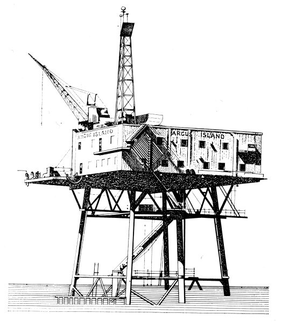
A line drawing of Argus.
There was a helipad on the deck at the very top, (this is visible in the other photo above) and an interior staircase descended to the living quarters one floor down (on the upper floor of the big box). Another staircase led down to the electronics labs on the lower floor.
Then there was another short flight down to the understructure, where scientific instruments could be rigged onto the aparatus for lowering into the ocean.
Then there was a long staircase down to the upper landing deck, originally, there were two staircases, but one got ripped away in a winter storm, and ended up on the ocean floor between the tower legs. Finally a vertical ladder down to the lower landing deck, which could be used only on very calm days. Most often people were landed and off-loaded using a tarzan rope that dangled from a corner of the living quarters. There are stories of people enjoying a mid-Atlantic dip!! On really rough days, the crane would somehow lower a scrambling net onto which the people would cling and climb to safety, (But click here for a photo!!) I don't know the details of the latter, because I never experienced it. And when it got really, really rough, they evacuated the tower. Cargo was offloaded and onloaded using the crane.
November 2013.
There was a helipad on the deck at the very top, (this is visible in the other photo above) and an interior staircase descended to the living quarters one floor down (on the upper floor of the big box). Another staircase led down to the electronics labs on the lower floor.
Then there was another short flight down to the understructure, where scientific instruments could be rigged onto the aparatus for lowering into the ocean.
Then there was a long staircase down to the upper landing deck, originally, there were two staircases, but one got ripped away in a winter storm, and ended up on the ocean floor between the tower legs. Finally a vertical ladder down to the lower landing deck, which could be used only on very calm days. Most often people were landed and off-loaded using a tarzan rope that dangled from a corner of the living quarters. There are stories of people enjoying a mid-Atlantic dip!! On really rough days, the crane would somehow lower a scrambling net onto which the people would cling and climb to safety, (But click here for a photo!!) I don't know the details of the latter, because I never experienced it. And when it got really, really rough, they evacuated the tower. Cargo was offloaded and onloaded using the crane.
November 2013.
Getting on Board!
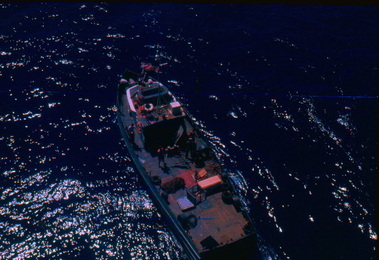 Mac-3 from the top deck of Argus Island.
Mac-3 from the top deck of Argus Island.
I was fortunate to spend 3 days and 2 nights on Argus Island testing the Ocean Bottom Seismograph Current Meter (OBSCM) with Graham Lobb in the mid-60s. This photo was taken during the unloading of cargo. The crane operator on Argus would lower
the hook to the 'correct' depth, Mac-3 would reverse towards it, one of the crew would grab it, hook it onto whatever was going aloft, give the signal, and as soon as the cargo was off the deck ...
the hook to the 'correct' depth, Mac-3 would reverse towards it, one of the crew would grab it, hook it onto whatever was going aloft, give the signal, and as soon as the cargo was off the deck ...
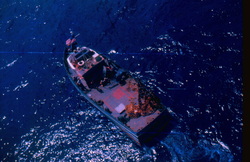 Mac-3 from the top of Argus Island
Mac-3 from the top of Argus Island
. ... Mac-3 would gun the engines before she got sucked under the tower. it took only a few seconds! What a great crew, and teamwork from both sides.
Transferring personnel between the Tower and Mac-3 used one of 3 methods depending on the serverity of the weather. The medium weather method used a rope dangling from the living quarters overhead.
Transferring personnel between the Tower and Mac-3 used one of 3 methods depending on the serverity of the weather. The medium weather method used a rope dangling from the living quarters overhead.
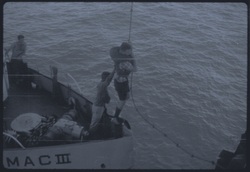 Offloading personnel from Mac-3 onto Argus Island.
Offloading personnel from Mac-3 onto Argus Island.
Mac-3 has nosed in towards the tower's landing stage (just visible in the bottom right, and Graham Lobb, perched right on the bows, has hold of the rope dangling from above. The crewman has a firm hold onto Graham's back. Mac-3 than backs away, and at the precise moment the crewman shouts "Go" and gives Graham a heafty push,
... and ...
... and ...
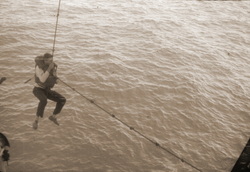
. ... Graham swings gently towards the landing platform on Argus Island. Someone on Argus has the end of the rope to give an added pull if necessary.
Dec 8th 2013.
~~~~~~~~~~~~~~~~~~~~~~~~~~~~~~~~~~~~~~~~~~~~~~~~~~~~~~~~~~~~~~~~~~~~~~~~~~~~~~~~~~~~~~~~~~~~~~~~~~~~~~~~~~~~~~~~~~~~~~~~~~~~
~~~~~~~~~~~~~~~~~~~~~~~~~~~~~~~~~~~~~~~~~~~~~~~~~~~~~~~~~~~~~~~~~~~~~~~~~~~~~~~~~~~~~~~~~~~~~~~~~~~~~~~~~~~~~~~~~~~~~~~~~~~~
I enjoyed my stay on Argus. Pleasant company, great food, a different film each evening (I remember 'Hud' (marginally impressed) and a drag race boy-meets-girl action movie - forgot the title.) The work went relatively smoothly, rigging the current meter and direction vane to the hoist, connecting to the cable, and lowering it to the bottom. Lost only one pair of pliers overboard, but Smokey Wingood, who was working on the sea floor, recovered them the next day. A couple of 'work-related' photos below.
Posted April 2014
~~~~~~~~~~~~~~~~~~~~~~~~~~~~~~~~~~~~~~~~~~~~~~~~~~~~~~~~~~~~~~~~~~~~~~~~~~~~~~~~~~~~~~~~~~~~~~~~~~~~~~~~~~~~~~~~~~~~~~~~~~~~~~~~~~
~~~~~~~~~~~~~~~~~~~~~~~~~~~~~~~~~~~~~~~~~~~~~~~~~~~~~~~~~~~~~~~~~~~~~~~~~~~~~~~~~~~~~~~~~~~~~~~~~~~~~~~~~~~~~~~~~~~~~~~~~~~~~~~~~~
The Power of the Ocean.
During the previous winter, there was a strong winter storm. One of the staircases between the lower
deck and the understory broke loose during this storm, and ended up on the seabed 180 feet below, between
the legs of Argus Island. The diving company, McDaniel & Windgood, was called in to survey the tower to be sure
there was no structural damage to the legs and cross-bracing below the waterline. Apparently, there was none
(or whatever damage that occurred was fixable) and the tower continued to be in service and occupied.
For whatever reason, it was decided some months later to remove the staircase from the seabed. This
operation was conducted during the time I was working there on the OBSCM project, and I was allowed to
photograph the staircase as it was being raised to the surface. (Photography was strictly forbidden inside the building.)
During the previous winter, there was a strong winter storm. One of the staircases between the lower
deck and the understory broke loose during this storm, and ended up on the seabed 180 feet below, between
the legs of Argus Island. The diving company, McDaniel & Windgood, was called in to survey the tower to be sure
there was no structural damage to the legs and cross-bracing below the waterline. Apparently, there was none
(or whatever damage that occurred was fixable) and the tower continued to be in service and occupied.
For whatever reason, it was decided some months later to remove the staircase from the seabed. This
operation was conducted during the time I was working there on the OBSCM project, and I was allowed to
photograph the staircase as it was being raised to the surface. (Photography was strictly forbidden inside the building.)
|
This early photo of Argus Island shows the 2 staircases, - one can be seen diagonally down from right to left, and the other, at a right angle to the former in the right-centre of the understory, with the square security gate quite visible. Other (later) photos show only one staircase. The 2 thick vertical ‘things’ to the left of centre are cables from the lab upstairs to the instruments underwater. There were 2 SOSUS arrays of hydrophones reaching out from Argus Island, one towards the North-West and the other to the South-West. Putting 2 & 2 together, it seems likely that these cables were for those 2 arrays. |
Argus Island Photos.
Additional photos of Argus Island collected from various sources
